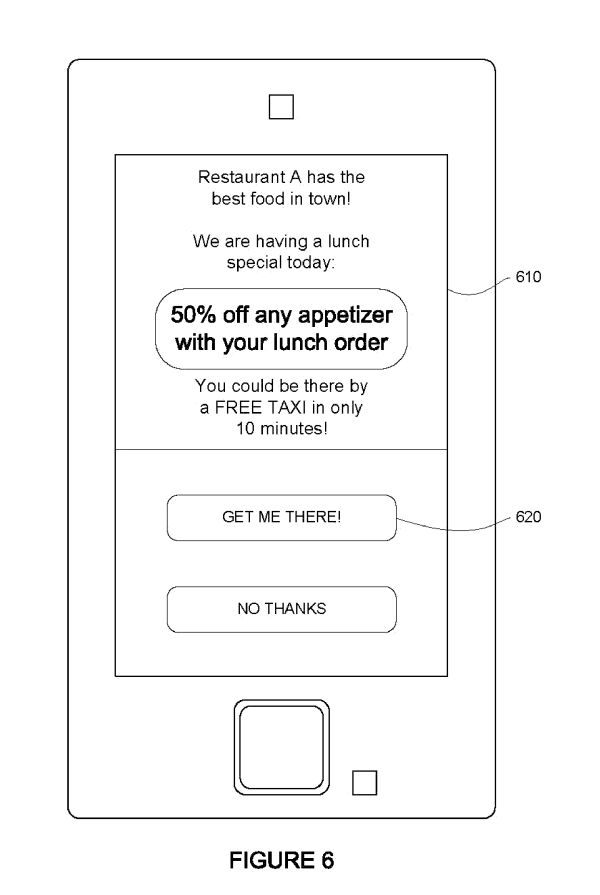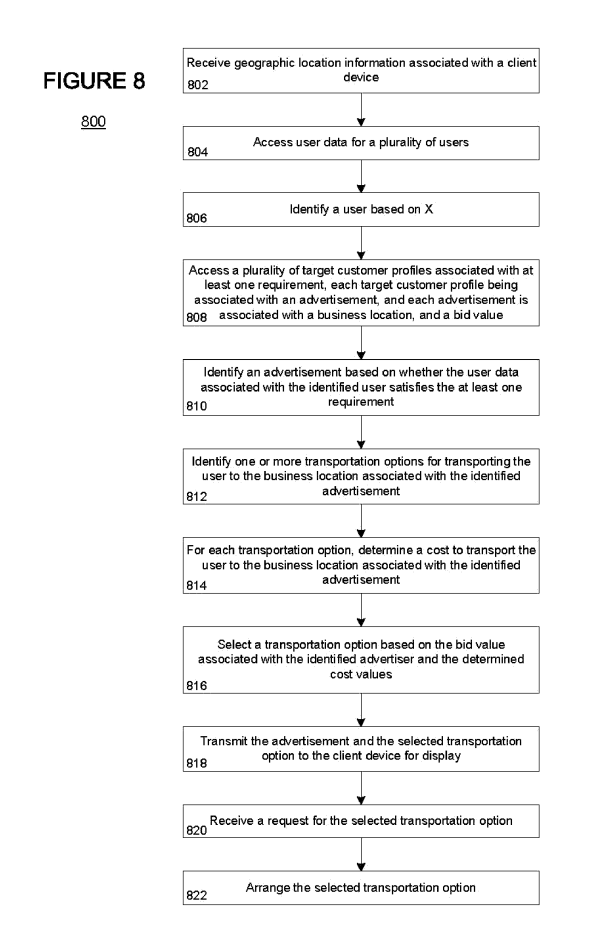Coming To Google: Click On Ad, Get Free Ride To Merchant Or Restaurant?
The day may be near when AdWords advertisers can offer customers immediate transportation to bring them to their locations right from an ad. Google has been awarded the patent for “Transportation-aware physical advertising conversions” US 8630897 B1 which essentially allows advertisers to show a sort-of transportation ad extension offering free or discounted travel to their […]
 The day may be near when AdWords advertisers can offer customers immediate transportation to bring them to their locations right from an ad. Google has been awarded the patent for “Transportation-aware physical advertising conversions” US 8630897 B1 which essentially allows advertisers to show a sort-of transportation ad extension offering free or discounted travel to their stores.
The day may be near when AdWords advertisers can offer customers immediate transportation to bring them to their locations right from an ad. Google has been awarded the patent for “Transportation-aware physical advertising conversions” US 8630897 B1 which essentially allows advertisers to show a sort-of transportation ad extension offering free or discounted travel to their stores.
A hair salon could include free or discounted transportation in its ads displayed during lunch hour to nearby office parks. Or as in Google’s own example illustrated below, a restaurant could offer a lunch offer along with free taxi service to users within a targeted geographic area.
Google filed the patent application just over three years ago on January 11, 2011. From offering bus vouchers, taxi rides and yes, eventually a ride via “autonomous vehicle” (aka Google’s self-driving car, though the patent even addresses autonomous helicopters), Google will be able to map what it knows about municipal and local transportation options to an advertiser’s “potential profit from a completed transaction using real-time analysis”.
For example, the system may consider various factors including a consumer’s current location, the consumer’s most likely route and form of transportation (such as train, personal car, taxi, rental car, or shared vehicle), the consumer’s daily agenda, the price competing advertisers are willing to pay for the customer to be delivered to alternate locations, and other costs. In this regard, the customer’s obstacles to entering a business location are reduced while routing and cost calculations are automatically handled based on the demand for the advertiser’s goods and potential profit margins.
Did you catch that part about “the consumer’s daily agenda”? Ad personalization (and creep factor) gets taken to a new level in this patent as well. In addition to using cookies and prior web queries, the ad targeting capabilities here are driven by data included in user profiles, from demographic and income data to transportation preferences (i.e. “I only want to take an autonomous vehicle”). And so as not to be shown ads for happy hour specials when they’ve got solid meetings booked, for example, a user may provide Google’s server with “access to the user’s personal calendar or a personal web site.”
The patent authors very briefly mention the privacy implications of all this. “Preferably, privacy protections are provided for the user data including, for example, filtering of sensitive information, encryption, hashing or filtering of sensitive information to remove personal attributes, time limitations on storage of information, or limitations on data use or sharing.”
How Will Bidding Work?
You can see in this patent how the bid modifier structure of enhanced campaigns was already being thought about in early 2011.
Advertisers will be able to modify bids based on user proximity, time of day, as well as on user profile data, buying history and expected profit margins.
Here are three bidding scenarios laid out in the patent application:
For example, an advertiser may bid $5.00 to reach males, $5.50 to reach females, and reduce bids by 70% during non-business hours.
For example, an advertiser may select to place a higher bid in order to transport a customer who has indicated an interest in high end retail goods and less to transport a customer who has indicated an interest in less expensive goods as profit margins may be significantly lower.
For example, advertisers may bid more to have customers which consistently use the transportation service to make purchases as compared to those who appear to travel without actually having made any purchases. These purchases may be tracked, for example, using discount codes, passphrases, badges, or standard advertising conversion modes.
Ads can be served on mobile devices, desktop, and even kiosk. From one of these kiosks, users could dispatch an autonomous vehicle or taxi or be given direction to nearby public transportation. How will advertisers be charged?
How will advertisers be charged?
The patent lays out several options for charging advertisers for “transportation-aware physical advertising conversions”. Scenarios listed include charging by ad impression, after a customer has requested a pick-up or been dropped off at the location, or even after the customer completes a transaction at the business.
And rather than stranding customers, “Advertisers may also bid on having an autonomous vehicle return to the business location to take the customer home or back to the original pick up location.”
Below is an illustration of the ad delivery process.

Of course, this is early days, but it’s interesting to begin to see the convergence of Google’s self-driving car technology and its map and local transportation knowledge with its ad business.
H/T Techcrunch
Contributing authors are invited to create content for MarTech and are chosen for their expertise and contribution to the search community. Our contributors work under the oversight of the editorial staff and contributions are checked for quality and relevance to our readers. MarTech is owned by Semrush. Contributor was not asked to make any direct or indirect mentions of Semrush. The opinions they express are their own.
Related stories